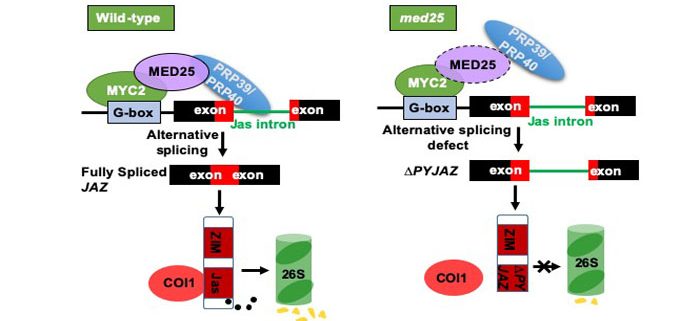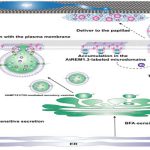MED25 regulates the alternative splicing of JAZ genes through recruitment of splicing factors PRP39 and PRP40
Wu et al. investigated MED25 recruits splicing factors to regulate the alternative splicing of JAZ genes in Arabidopsis. The Plant Cell (2019). https://doi.org/10.1105/tpc.19.00583
Background: The jasmonate (JA) signaling pathway controls resource allocation between growth- and defense-related processes, thus playing a critical role in optimizing plant adaptation to rapidly changing and often hostile environmental conditions. Therefore, the activation and the deactivation/desensitization of JA responses must be under tight control. JA-induced production of dominant JAZ splice variants provides a general mechanism to desensitize JA responses.
Question: It is unclear how plants control the generation of dominant JAZ splice variants to proper levels to prevent excessive and/or uncontrolled desensitization of JA signaling. Prominently, the splicing factors involved in Jas intron-dependent alternative splicing of JAZ genes and how these splicing factors are recruited remain enigmatic.
Findings: We show that the generation of JAZ splice variants depends on the Mediator subunit MED25 and that MED25 recruits the splicing factors PRP39a and PRP40a to prevent the over-production of JAZ splice variants. Our results suggest that the MED25–PRP39a/PRP40a module acts to prevent the excessive desensitization of JA responses by promoting the full splicing of Jas intron. Our results support a scenario in which the multitalented MED25 acts as a central coactivator of MYC2-dependent transcriptional regulation of JA signaling in a highly organized manner.
Next steps: One interesting direction for future exploration is to dissect the molecular mechanism of the functional specificity of PRP39 and PRP40 in regulating the alternative splicing of JAZ genes.
Wu, F., Deng, L., Zhai, Q., Zhao, J., Chen, Q., and Li, C. (2019). Mediator Subunit MED25 Couples Alternative Splicing of JAZ Genes with Fine Tuning Jasmonate Signaling. https://doi.org/10.1105/tpc.19.00583
Keywords: jasmonate, splicing.




